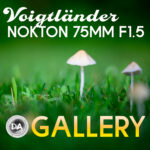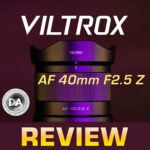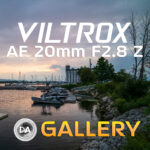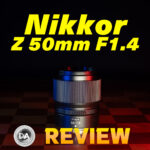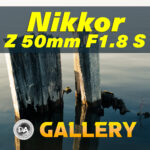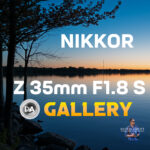
Ahhh, it is nice to be reviewing another Voigtländer lens! My last Voigtländer review was back in 2020, and it was actually a review of the APO-Lanthar 50mm F2 that a subscriber had personally loaned me because I had no access to Voigtländer products here in Canada because of their not having a Canadian distributor (at least that I was aware of) and a complication with sending their products across the border from the US. Fortunately that has all changed for the better, and early this year I received an email that I was very happy to get – a “hello” from JCL Sales Group, the distributor for Voigtländer in Canada. They wanted to know if I was interested in doing more Voigtländer reviews, to which I responded, “absolutely!”

I’ve got a bit of soft spot for Voigtländer lenses, having owned three of them and currently using one that I do own (APO-Lanthar 65mm F2 Macro) on a regular basis. That has only grown since Zeiss has seemingly transitioned away from producing non-cine camera lenses, leaving Voigtländer as the only company filling that unique niche of premium manual focus lenses. Voigtländer is actually the oldest surviving lens maker, and is a company that traces its roots to Vienna, Austria, in the mid 1700s. Like Zeiss (a German company), the more modern lenses have been produced in Japan by Cosina, and there is just something special about their optical glass that produces gorgeous colors. Today’s review is of one of their newest lenses – the Voigtländer Nokton 75mm F1.5. I’m reviewing it in Nikon Z-mount, though I know that a Sony E-mount (and perhaps other mounts) are on the way. If you want my full thoughts on this lovely new lens, you can either watch my video review below…or just keep reading.
Follow Me @ YouTube | Patreon | Instagram | Facebook | DA Merchandise | Flickr | 500px | X
__________________________________________________________________________________________________
Thanks to JCL Sales Group for sending me a review loaner of this lens. As always, this is a completely independent review. All opinions and conclusions are my own. *The tests and most of the photos that I share as a part of my review cycle have been done with the 45MP Nikon Z8, which I reviewed here.
__________________________________________________________________________________________________
Voigtländer lenses follow a tried and true formula that has been true across the four different mounts that I’ve tested them on. This includes a premium build that is all metal and glass, well executed aperture and focus rings, electronic contacts to communicate EXIF data and to enable more manual focus aids, but no weather sealing. Their lenses tend to be more like classic Zeiss lenses in build but typically smaller and less extreme in size. All of this is true here, and while the Nokton 75mm isn’t a small lens, it is only moderately sized.

There are two aspects of Voigtländer lenses that I enjoy: 1) the beautiful manual focus action and 2) the uniquely beautiful rendering and image quality.

So is the new Nokton 75mm F1.5 worth the roughly $900 USD price tag? Read on to find out.
Build and Handling
There are essentially two different variations of the Voigtländer design language in use right now. We have a classic “knurled” style to the manual focus ring as seen on this Nokton 75mm F1.5 (and my older APO-Lanthar 65mm F2) and then also a diamond pattern grip surface seen on the Nokton 50mm F1.0 (shown here in Sony e-Mount).

The Nokton 75mm is the classic anodized metal look that is broken up by 3 different textured grip surfaces. Closest to the lens mount in a thin ring of ridges that is just a textured area for grabbing the lens and twisting it to remove it from the mount. This area is not moveable.

This section of the barrel also has the hyperfocal markings from F8 to F32 for those who like to utilize that method for focus.
The next section is the manual focus ring. As noted, this has a knurled grip pattern and moves with the perfectly damped smoothness that Voigtländer is famous for. These focus rings are beautifully engineered, with the perfect balance between enough resistance for precision and enough freedom for smooth, gliding focus. There is roughly 180° of focus throw (rotation), which is about perfect, in my opinion. It’s long enough to allow for precision, but not so long that you have to make multiple rotations of the wrist to make major focus changes.

Markings are etched and painted, with yellow for Imperial (feet) and white for metric (Meters). The inner barrel will extend about 16mm during focus (this is not an internally focusing lens), with the extension coming towards the minimum focus side (the lens is fully retracted at infinity focus).


The third ring is the aperture ring, and it is located closest to the front of the lens. The aperture ring is clicked (there is no declick option) with detents on the one-third stop aperture positions. The aperture range on the lens is unusually large, going from F1.5 to as small as F32. That means this aperture ring has longer travel than usual, but it feels very precise.

The aperture iris itself has a high blade count of 12. This is appreciated, as Voigtländer works with straight blades in their apertures, so a higher blade count helps retain a more circular shape at smaller apertures. There are ten blades in my APO-Lanthar 65mm, and I do see the shape sometimes.

Up front we have a somewhat uncommon 62mm front filter thread size along with some badging regarding the lens designation.

There is an included narrow lens hood that threads onto those metal filter threads, but fortunately the filter threads are repeated inside the hood so that you can continue to use filters when the hood is attached. A threaded lens hood can’t reverse for storage, so you’ll either choose to not use the hood or leave it threaded on all the time. The short length of it doesn’t means it isn’t much of a liability to leave it attached all the time. If you want to use a rotating filter like a circular polarizer, you will probably want to leave the hood off, however, as there just isn’t much room to reach in there and rotate the filter with the hood mounted.

At the rear of the lens you fill the electronic contacts that will communicate all relevant information to the camera. That will include EXIF information, information for IBIS (camera stabilization, if so equipped), and information for various manual focus aids. The lens basically handles as normal save that there is no autofocus nor the ability to change the aperture from within the camera.

I see no weather sealing gasket there, and no weather sealing is claimed for the lens.
The Nokton 75mm is on the small side of medium in terms of size. It is 74mm (2.9″) in diameter x 75.9mm (3″) in length. Due to the solid construction the weight is a little more substantial at 530g (18.7oz). It’s an easy fit on my more robust Z8 body, but still small enough to work fine on smaller cameras as well. You can see that it is substantially smaller than my 65mm F2.

The minimum focus distance is 50cm. This is considerably closer than most 85mm lenses, which tend to only allow focus as close as 80-85cm. The resulting magnification is higher than those lenses (typically 0.12-0.14x magnification) at a very useful nearly 0.21x times (1:4.8).

This allows for some interesting closeups with very shallow depth of field at F1.5!

All in all, the Voigtländer Nokton 75mm F1.5 was pretty much exactly what I expected. A very solid build with gorgeous engineering, but without any of the modern features that I typically evaluate in a lens at this price point ($899 USD). You buy a Voigtländer lens for different reasons that you buy a Sigma, and there is nothing here that will disappoint those who love and appreciate quality manual focus lenses.
Manual Focus on Nikon (Z8)

My recent purchase of the Nikon Z8 is the first time that I personally owned a Nikon body. I did a lot of research ahead of buying the Z8, and felt like it was the best fit for my needs. While manual focus was not a primary consideration in my purchase, I’ve actually really enjoyed the various Nikon focus aids and the overall focus experience on Nikon. Here’s a few reasons why:
- Clear, useful EVF. On paper, the EVF of the Z8 is nothing special, but, in practice, it works very well. I’ve got much higher resolution viewfinders on Sony cameras, but Sony viewfinders do some weird things when the shutter is half depressed. And I typically want the shutter half depressed when manually focusing, as this helps stabilize the viewfinder while I focus. Nikon’s viewfinder is clear and makes it easy to see focus moving as I turn the manual focus ring.
- Effective IBIS (VR). I’ve been impressed with the real world stability of Nikon’s in camera VR. It works effectively and allows for both a stable viewfinder experience as a I focus and also stable results when I take the shot. To my knowledge, no manual focus lens to this point has included lens-based image stabilization, so having effective in-camera stabilization is very important.
- Useful manual focus aids. There are three primary manual focus aids that I’ve utilized when manually focusing, including the onscreen focus confirmation box (put it where you want focus to be, and it will turn green when proper focus has been achieved), magnification of the image to visually confirm focus, and focus overlays (peaking). With some lenses Nikon includes a directional arrow that points you the direction you need to turn the focus ring to focus in the right direction, but that isn’t always the case. I’ve found that the focus box is quite accurate, though, and it makes manual focus fairly easy.
My one complaint is that it feels like magnification could be handled a little more effectively. Some camera brands allow for an automatic magnification of the focus area when you start to turn the focus ring (Sony, for example, and this is true with Voigtländer lenses that are true manual focus lenses but have electronic contacts). Nikon doesn’t do that, and so you have to manually choose to magnify the image. Also, when you’ve magnified the image and gone to depress the shutter, the camera does not automatically return to normal view to help assure that your composition is correct. This has to be handled manually as well. This just adds additional time to the focus process if you desire to visually confirm focus.
In general, however, I enjoyed using the Nokton 75mm on Nikon. I got good stabilization, good focus accuracy, and the lens seemed to work well in general on my Z8. While I certainly wouldn’t choose a manual focus lens for action, I was able to use the green box focus confirmation and snap this quick photo of a turkey at F1.5, and, as you can see from the crop, focus is nailed.


It is worth noting that the beautiful focus ring makes doing focus pulls during video a treat. There’s nothing quite like a well calibrated true manual focus ring for smooth pulls.
Image Quality Breakdown
The term “Nokton” in the name of this lens is a reference to “nocturnal”, and emphasizes its ability in low light due to the bright maximum aperture. The optical formula here is relatively simple, with just 7 elements in 6 groups. Of those elements, one is an aspherical element, while three are unique low dispersion elements.

There are some Voigtländer lenses that are exquisitely sharp, while others like the Nokton 40mm F1.2 that have more of a dual personality – a bit “dreamy” at large apertures while extremely sharp when stopped down. The Nokton 75mm F1.5 falls somewhere in between, in that it is quite sharp even wide open, but not to the level of my APO-Lanthar 65mm F2, and then is extremely sharp when stopped down. What I find to be fairly universal among Voigtländer lenses is the gorgeous color rendition. I love their optical glass, and there’s something about the look of the images right out of the camera that is special. I often find that I do next to no processing or tweaking to images, as it is rather hard to improve on what is already there.

You really notice this when shooting more shallow depth of field shots, as the blend of the beautiful colors, defocused area, and then even the nature of the vignette creates very artful images.

On the technical side of things, there is little to no distortion but a meaningful amount of vignette.

There is the tiniest amount of pincushion distortion (-1 to correct) and about two stops of vignette (+58 to correct). Nothing significant to see.
This is not one of their Apochromatic designs, so it isn’t entirely free of fringing, but I saw little color fringing (LoCA) either before or after the plane of focus.

That was true in real world shots, too. What I did see is a little bit of “blooming” around some of the edges of things like these flowers, which does produce a very slight “dreamy” effect, though nothing like the 40mm F1.2.


Control of Lateral CA was pretty much perfect. The transition from black to white is flawless near the edge of the frame.

A great start! So how about sharpness and contrast? All of my chart tests are shot on the 45MP Nikon Z8 sensor with crops shown at roughly 200% magnification. Here’s a look at the test chart.

And here are the F1.5 crops from across the frame:



Center detail is good, but contrast isn’t great. The mid-frame looks the weakest of the bunch, as the corners rebound surprisingly well. The corner performance is probably the most standout.
Other than the bit of bloom on the textures, I found that real world sharpness at F1.5 was very usable.


Stopping down to F2 definitely increases contrast and also there is some increase in resolution. The center of the frame has obviously higher contrast.

Though corners were already strong, contrast looks obviously better there at F2 as well.

By F2.8 results are high contrast and detail across the frame.

From F4-F8 image quality is pristine all across the frame. There is high contrast and detail everywhere I look in the frame. Landscapes look fantastic due to the rich colors and excellent contrast. That excellent optical glass really shines!



The Nokton 75mm really has the ability to delineate fine details. Take this F5.6 shot of a river scene. If you look to the left of the island on the right of the frame you might see a little dot.

Zooming DEEP into the image reveals that the dot is a kayaker, and you can even make out the towel of someone on the beach in front of the cottage beyond.

That’s at nearly 300% magnification, and the fact that this much detail is visible is pretty impressive.
Minimum aperture is a very small F32 (unusual for a lens with such a large maximum aperture). Sharpness is strong through F11, but at smaller apertures (F16 and beyond), diffraction will begin to soften the image.

The Nokton 75mm F1.5 is a lens capable of very useful sharpness wide open and exceptional sharpness when stopped down.
But that may not be the biggest reason to purchase the lens. If sharpness is all you are looking for, there are alternative lenses that can achieve similar levels of sharpness. The better reason to choose the Nokton 75mm is for the overall rendering – that unique blend of color, out of focus rendering, and “look” to images that is just special.

That’s right out of camera without editing. The general look of the image, even with a simple subject, is just great.
Look at how beautiful the greens are here :

Here’s another unedited shot of a close-up of one of my vintage bellows cameras.

I’m not saying there aren’t situations where I wouldn’t want to remove some vignette, but in many cases, like with a Zeiss lens, the vignette is intentionally part of the look. In many images it just works, like this F1.5 shot of some roses.

The only fly in the ointment for some may be the straight aperture blades and the effect this has on specular highlights (bokeh balls). You will see those straight blades, though the high blade count makes this less of an issue. Here’s a look at what F2.8 looks like:

The “Nokton” part of the equation means that this lens is useful for shooting in dim lighting conditions. The bright maximum aperture of F1.5 (oddly not F1.4) allows for good light gathering, and manual focus assures that autofocus won’t complicate things in dim lighting.

I could put focus exactly where I wanted when I shot these bees in front of one of my hives. It was a hot day, and these middle aged worker bees were tasked with cooling the hive. They poise themselves in front of the hive entrance, anchor down, and flap their wings at a very high rate to help produce air flow into the hive. Pretty amazing!

Flare resistance is so-so. It is fairly easy to compose without getting too much negative from a bright light source wide open. The final image in this series is shot with the sun right out of frame, and you can see that there is no negative impact. But at certain angles you will see some ghosting patterns and a bit of loss of contrast. When stopped down the straight aperture blades aren’t much of an advantage, as the sunstar just looks busy to me. When panning the camera across the sun at small apertures I also saw a bit of flashing with the sun at certain angles.



That being said, it isn’t flare-prone in normal shooting conditions, and, while I could create some negative effects if I tried (the coatings aren’t perfect!), I also wasn’t really impacted under normal shooting conditions.
All in all, this is a strong optical performance. Yes, there is a little less contrast at F1.5, but that’s by design to allow for a special kind of “look”, and I find that it works well in real world shots. Images in general just look beautiful from the Voigtländer Nokton 75mm F1.5.

You can see more by visiting the lens image gallery here.
Conclusion
As you can probably tell, I’ve enjoyed my time spent with the Voigtländer Nokton 75mm F1.5. It’s been fun to not only get to use a beautiful new Voigtländer optic, but also to get to explore it on what is a completely new platform for me. The Nokton 75mm and my new Nikon Z8 have been excellent companions, and have produced a lot of very nice images for me.

The Nokton 75mm F1.5 is a beautifully made lens that is small enough to be a nice fit on most all Nikon Z-mount bodies. As per usual, the focus and aperture rings are perfectly executed, making manual focus and general handling great…if you love manual focus lenses.

Manual focus lenses have long been for a certain niche market. Many photographers have no interest in a lens without autofocus, and that’s okay. Voigtländer has managed to remain successful in the modern era because they are in touch with their actual audience. I certainly wouldn’t want to shoot exclusively with manual focus lenses, and I don’t like them for all types of photography, but I do love them for many of the kinds of shots that I’ve shared in this review. Shooting still subjects, taking my time, and enjoying the process of watching focus glide along until it hits the perfect spot where you want it to be. Years ago I wrote an article for Digital Photography School called, “Why Every Photographer Should Use a Manual Focus Lens.” The premise of that article was that using a good manual focus lens helps you become a better photographer. It makes you consider depth of field and its relationship with aperture, think more about composition and focus, and slows you down so that you can become a little more deliberate and even artistic in your thought process. If you’re interested in manual focus, and think that 75mm might be an interesting focal length, then the Voigtländer Nokton 75mm F1.5 should definitely be on your short list of potential new lenses.

Pros:
- Beautifully built lens
- Perfectly executed focus ring
- Compact size
- Focus aids and EXIF info works perfect on Nikon
- Very low distortion
- Low fringing
- Good wide open sharpness
- Outstanding sharpness when stopped down
- Gorgeous colors
- Great rendering
- Nice bokeh
Cons:
- No weather sealing
- A declick option for the aperture would be nice
- Contrast isn’t amazing at F1.5
_________________________________________________________________________
GEAR USED:
Purchase the Voigtländer Nokton 75mm F1.5 @ B&H Photo | Adorama | Amazon | Amazon Canada | Amazon UK
_______________________________________________________________
Purchase the Nikon Z8 @ B&H Photo | Adorama | Amazon | Camera Canada | Amazon Canada | Amazon UK | Amazon Germany
_________________________________________________________________
Want to support this channel? Use these affiliate links to shop at: B&H Photo | Amazon | Adorama | Camera Canada | Amazon Canada | Amazon UK | Ebay | Make a donation via Paypal
Buy DA Merchandise https://bit.ly/TWIMerch

Keywords: Voigtländer, Voigtlander, Nokton, 75mm, F1.5, Voigtländer Nokton 75mm F1.5, Nikon, Nikon Z8, Z, Z-mount, Z8, Review, mirrorless, Full Frame, Sports, Tracking, Dustin Abbott, Real World, Comparison, Handling, Focus, Portraits, Resolution, High ISO, Image Quality, Sample Images, Photography, 45MP, #letthelightin, #DA, #NIKON, #Z8, #NIKONZ8

